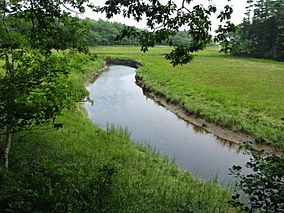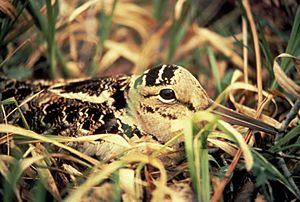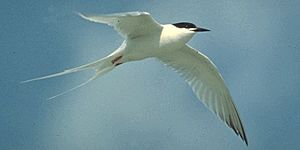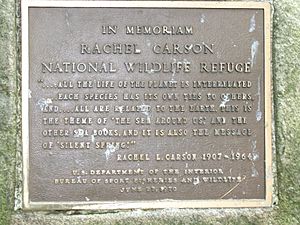Rachel Carson National Wildlife Refuge facts for kids
Quick facts for kids Rachel Carson National Wildlife Refuge |
|
|---|---|
|
IUCN Category IV (Habitat/Species Management Area)
|
|

Tidal salt marsh at the Rachel Carson National Wildlife Refuge in Wells, Maine.
|
|
| Location | Cumberland County, York County, Maine, United States |
| Nearest city | Kennebunk, Maine |
| Area | 9,125 acres (36.93 km2) |
| Established | 1966 |
| Governing body | U.S. Fish and Wildlife Service |
| Website | Rachel Carson National Wildlife Refuge |
The Rachel Carson National Wildlife Refuge is a special protected area covering about 9,125 acres (3,693 km2) along 50 miles (80 km) of Maine's southern coast. It was created in 1966. The refuge is named after Rachel Carson, a famous writer and environmentalist. Her book Silent Spring helped people understand how chemicals like DDT harmed migratory birds and the environment.
The refuge is made up of many different pieces of land. These protected areas stretch between Kittery and Cape Elizabeth. They include land in towns like Wells, Kennebunk, Kennebunkport, Biddeford, Saco, and Scarborough.
This refuge protects about 1,167 acres (472 km2) of salt marshes and higher lands that drain into the Webhannet River. This is about one-ninth of the river's entire watershed. The main office for the refuge is located on Route 9 in Wells.
The refuge protects many different kinds of natural places. These include barrier beaches, dunes, tidal estuary areas, salt marshes, and rocky coastlines. The piping plover, a bird that is in danger of disappearing, builds its nests on the refuge's land.
Contents
Protecting Wildlife and Habitats
The Rachel Carson National Wildlife Refuge was created to save ten important estuaries. Estuaries are places where fresh river water mixes with salty ocean water. These areas are very important stops along the migration routes for waterfowl and other birds.
During cold winters, the refuge's marshes offer food and shelter for birds. This is especially helpful when other inland waters are frozen. The refuge also helps protect rare birds like the piping plover, least terns, peregral falcons, and bald eagles. These are species that are protected by state and federal laws.
When the refuge protects these nesting areas, more plovers and terns survive. Many important fish and shellfish also rely on these coastal wetlands. They use them as safe places to grow up.

The refuge covers over 9,125 acres (3,693 km2) in eleven different areas. These areas stretch from Kittery to Cape Elizabeth, Maine. In 1989, the refuge grew to include more salt marshes, freshwater wetlands, and important "edge" lands around its nine divisions. The tenth division, Biddeford Pool, was also added. This area is a key resting spot for many different shorebirds. In 2007, the eleventh division, the York River Division, was added. When all the planned land is bought, the refuge will be about 14,600 acres (5,908 km2).
In 1984, a National Estuarine Research Reserve was set up in Wells, Maine. This reserve includes parts of the refuge's Upper and Lower Wells divisions. The reserve and refuge work together to help people learn more about estuaries. Their goal is to encourage people to care for and protect these important natural areas.
Threatened and Endangered Animals
The piping plover is a bird that is considered federally threatened and state endangered in Maine. This means it is at high risk of disappearing. About 50% to 75% of Maine's piping plover population nests on or near the refuge. Important nesting spots include Crescent Surf Beach, Goosefare Brook, and Marshall Point at Goose Rocks.
New England cottontails (Sylvilagus transitionalis) are a type of rabbit found in Maine. These rabbits like young, growing habitats. This type of habitat was common in the early to mid-1900s. As farms were left empty, the rabbits did very well. But as more land was developed or grew into forests, their habitat became rare. Because of this, the refuge stopped allowing rabbit hunting in 1998. The New England cottontail is now listed as an endangered species in Maine.
Migratory Birds of the Refuge
Many different types of birds visit or live in the refuge.
Salt Marsh Birds
In 1995, sharp-tailed sparrows were split into two species: the Nelson's sharp-tailed sparrow (Ammodramus nelsoni) and the saltmarsh sharp-tailed sparrow (Ammodramus caudacutus). Both types of sparrows are found only in the salt marshes of the refuge. The saltmarsh sharp-tailed sparrow spends its entire life in these salty marsh habitats.
Waterbirds
Common loons (Gavia immer) visit the lower parts of the refuge's tidal creeks from late autumn to early spring. They are often seen eating green crabs and small fish. During spring, summer, and autumn, 11 different types of wading birds use the refuge's estuary systems as they migrate.
Waterfowl
Twenty-six different kinds of waterfowl have been seen at the refuge. The most common ones include the American black duck (Anas rubripens), Canada goose (Branta canadensis), mallard (Anas platyrhynchos), and green-winged teal (Anas carolinensis). Other common waterfowl are the common goldeneye (Bucephala clangula), bufflehead (Bucephala albeola), and red-breasted merganser (Mergus serrator).
Dabbling ducks like to feed in shallow salt pannes and the upper parts of tidal creeks. Diving ducks prefer deeper parts of the creeks and river mouths. Black ducks, mallards, and Canada geese all breed in the refuge. Wood ducks (Aix sponsa) also breed in the Upper Wells and Mousam River Divisions each year.
Shorebirds
Southern coastal Maine is a very important stop for many North American shorebirds. Thousands of shorebirds feed along the beaches and mudflats as they migrate through the state. Biddeford Pool is one of the best places in southern Maine for shorebirds to gather.
Common shorebirds seen in the autumn include the semipalmated plover (Charadrius semipalmatus) and black-bellied plover (Pluvialis squatarola). You might also see least sandpiper (Calidris minutilla), greater yellowlegs (Tringa melanoleuca), and short-billed dowitcher (Limnodromus griseus). These birds usually feed in the mudflats when the tide is low. Most shorebirds feed in salt pannes and rest in these areas or nearby uplands during high tide.
Gulls and Terns

Herring gulls (Larus argentatus) and great black-backed gulls (Larus marinus) are the most common gulls at the refuge. They are seen throughout the year, especially in autumn and winter. They rest on the marsh and tidal flats. Ring-billed gulls (Larus delawarensis) are also common. During autumn and winter, Bonaparte's gulls (Larus philadelphia) feed and rest at the mouths of tidal creeks and rivers.
Least terns nest in several spots in the refuge. In the 1980s, common terns nested in the salt marsh. Roseate terns (Sterna dougallii) have also been seen nesting. In 2003, Crescent Surf Beach had the largest nesting colony of least terns in Maine. The refuge works to protect these nests from predators like crows and coyotes. Least terns also nest at other beaches nearby.
Land Birds
Over 120 types of land birds have been seen at the refuge, with more than 72 species nesting there. Some of these include the great crested flycatcher (Myiarchus crinitus), tree swallow (Tachycinata bicolor), and hermit thrush (Catharus guttata). You might also spot the black-throated green warbler (Dendroica virens) and scarlet tanager (Piranga olivacea).
The forests and swamps around the refuge's salt marshes are home to many raptors (birds of prey). Many migrating raptors use these forested areas to hunt. Sharp-shinned hawk (Accipiter striatus) and Cooper's hawk (Accipiter cooperii) have nested in the refuge's forests. Northern goshawks (Accipiter gentilis) and red-tailed hawks (Buteo jamaicensis) also nest in the area. Northern harriers are the only raptors thought to breed in the refuge's estuary areas.
Mammals of the Refuge
White-tailed deer (Odocoileus virginianus) are the most common mammal seen at the refuge. Their trails can be found through parts of the salt marsh. They are often seen along the edges of the marsh and in the surrounding forests.
Raccoon (Procyon lotor) tracks and droppings are common everywhere. They are often found along the edges of tidal creeks and salt pannes, where raccoons look for crabs and small fish. It's important to tell their tracks apart from those of river otters (Lutra canadensis). River otters also hunt a lot in the marshes. River otters are sometimes seen in the salt hay along tidal creeks.
Mink (Mustela vison), striped skunk (Mephitis mephitis), red fox (Vulpes fulva), and coyote (Canis latrans) also hunt in the estuary. Beaver (Castor canadensis) and muskrat (Ondatra zibethicus) are sometimes seen swimming in tidal creeks.
A few spots in the refuge are used by harbor seals (Phoca vitulina) to rest on land. More seals use these spots in winter, but some are seen all year. During winter, harp seals (Pagophilus groenlandicus) and sometimes hooded seals (Cystophora cristata) and grey seals (Halichoerus grypus) can be found resting on the refuge's salt marshes and in the water offshore.
Many large mammals are found near the refuge. Moose (Alces laces) and black bear (Ursus americanus) are becoming more common in southern Maine. They have been seen in all parts of the refuge except Moody. A bobcat (Lynx rufus) was seen using parts of the refuge in the early 1990s. Fishers (Martes pennanti) are also being seen more often. Gray fox (Urocyon cinereoargenteus) and short-tailed weasel (Mustela erminea) likely use several parts of the refuge. Porcupines (Erethizon dorsatum) and woodchucks (Marmota monax) are found throughout the refuge in different habitats.
Snowshoe hares (Lepus americanus) live in the forests with thick undergrowth. White-footed mice (Peromyscus leucopus), meadow jumping mice (Zapus hudsonius), and meadow voles (Microtus pennsylvanicus) sometimes use the edge of the salt marsh habitat. Other small mammals found in the refuge include the eastern chipmunk (Tamias striatus), American red squirrel (Tamiasciurus hudsonicus), and eastern grey squirrel (Sciurus carolinensis).
Reptiles and Amphibians
The refuge has some freshwater cattail marshes and ponds. But its higher lands have many rivers, uplands, and vernal pools. These are very important places for amphibians (like frogs and salamanders) and reptiles (like snakes and turtles).
Surveys have found many frogs breeding in the refuge, including the American toad (Bufo americanus), green frog (Rana clamitans), wood frog (Rana sylvatica), and bullfrog (Rana catesbeiana). Yellow-spotted salamanders (Ambystoma maculatum) and red back salamanders (Plethodon cinereus) are also common breeders.
Documented Species
Species seen in the refuge include the garter snake (Thamnophis sirtalis), ribbon snake (Thamnophis sauritus), and painted turtle (Chrysemys picta). The spotted turtle (Clemmys guttata), which is threatened in Maine, is also found here.
Fish in the Waters
The coastal marshes, bays, tidal creeks, and rivers in the refuge are home to many different shellfish and fish. You can find sunfish (Lepomis species), creek chub (Semotilus atromaculatus), American eel (Anguilla rostrata), and white sucker (Catostomus commersoni). Brook trout (Salvelinus fontinalis) and brown trout (Salmo trutta) are put into the rivers and estuaries each year.
The Ogunquit River has fish like alewife (Alosa pseudoharengus), blueback herring (Alosa aestivalis), and winter flounder (Pleuronectes americanus). The Webhannet River has native species like winter flounder, northern pipefish (Syngnathus fuscus), and Atlantic herring (Clupea harengus). The Mousam River attracts fish like striped bass (Morone saxatilis) and rainbow smelt (Osmerus mordax). These estuaries are considered "essential fish habitat" because they are vital for fish to spawn, breed, feed, and grow.
Types of Habitats
The Rachel Carson National Wildlife Refuge is made up of about 35% tidal areas, 10% freshwater wetlands, and 55% higher lands. Tidal habitats include beaches, dunes, rivers, rocky shores, and salt marshes. Freshwater wetlands include cattail marshes, bogs, and swamps.
Most of the higher land forests are a mix of oak and pine trees. However, you can also find hemlock, spruce, and pitch pine stands. The understory (the plants growing under the trees) has shrubs like Viburnums, winterberry, and blueberry. Other upland habitats include grasslands and thickets.
The refuge has a wide variety of habitats. It blends plants and animals from both southern oak-pine forests and northern coniferous forests. This mix creates a rich biodiversity (many different kinds of life) in southern Maine.
The refuge has special natural communities. These include a coastal dune marsh ecosystem, Spartina saltmarsh, white oak – red oak forest, dune grassland, and pitch pine bog.
Images for kids






